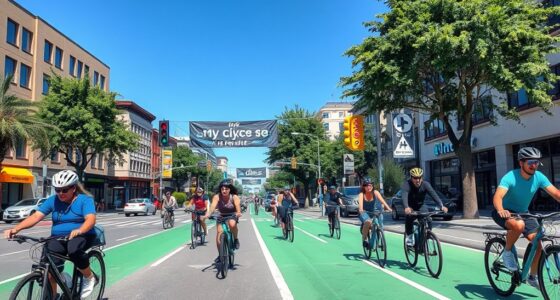Cycling advocacy 101 involves promoting safer and more accessible environments for cyclists through multiple strategies. Focus on improving bike lane safety by supporting features like physical separation and proper maintenance. Educate riders on safe practices and traffic laws to reduce accidents. Advocate for policies that fund infrastructure and safety programs, and engage your community through events and support. These efforts help transform cities into bike-friendly places—keep going to discover how you can make a difference.
Key Takeaways
- Promote the development and maintenance of safe, well-marked, and physically separated bike lanes to reduce conflicts with vehicles.
- Educate cyclists on safe riding practices, traffic laws, and signaling to increase confidence and reduce accidents.
- Advocate for policies that fund infrastructure improvements, safety audits, and rider education programs.
- Engage communities through events, workshops, and local initiatives to build support for cycling safety.
- Highlight the positive impacts of cycling advocacy in creating accessible, bike-friendly cities that encourage active transportation.

Have you ever wondered how cycling advocates are transforming cities into more bike-friendly places? It all starts with understanding the importance of bike lane safety and rider education. When cities prioritize creating dedicated bike lanes, they reduce conflicts between cyclists and motor vehicles, making cycling a safer and more appealing option. As a cyclist or supporter, you can push for protected bike lanes that are clearly marked, physically separated from traffic, and well-maintained. These features encourage more people to choose biking by alleviating fears of accidents and injuries. But infrastructure alone isn’t enough. Rider education plays a *crucial* role in fostering a safe and respectful cycling environment.
You can get involved in programs that teach both new and experienced riders about safe practices on the road. These programs cover *essential* skills, such as signaling turns, proper lane positioning, and understanding traffic laws. When cyclists are well-informed, they can navigate streets confidently, reducing the likelihood of accidents. Promoting rider education also helps dispel misconceptions that cycling is inherently dangerous. Instead, it highlights how proper training and awareness can make biking a safe, reliable mode of transportation. Advocacy efforts often include distributing safety materials, hosting workshops, or partnering with local schools and community groups to reach a broader audience.
Beyond infrastructure and education, advocating for policies that support bike lane safety and rider training makes a *significant* impact. You can lobby city officials to implement stricter standards for bike lane construction and maintenance. Pushing for regular safety audits ensures the infrastructure remains secure and accessible. Additionally, supporting legislation that funds rider education programs encourages cities to invest in the skills needed for safe cycling. These policies not only protect current cyclists but also attract new riders who might be hesitant due to safety concerns.
Community engagement is another *vital* aspect. Organize or participate in local cycling events, like safety clinics or group rides, to foster a culture of awareness and support. When people see the benefits of well-designed bike infrastructure and educated riders, they’re more likely to back policies that prioritize bike safety. Creating a community that values cycling encourages local governments to allocate resources for safer bike lanes and training initiatives.
In the end, transforming a city into a bike-friendly place hinges on your advocacy for bike lane safety and rider education. Your efforts help build an environment where cycling is accessible, safe, and enjoyable for everyone. By pushing for better infrastructure, promoting education, and supporting sensible policies, you become part of a movement that’s reshaping urban landscapes—one safe, confident rider at a time.
Frequently Asked Questions
How Can I Start a Local Cycling Advocacy Group?
To start a local cycling advocacy group, begin by identifying like-minded cyclists in your community. Organize a meeting to discuss goals and plan community outreach initiatives. Focus on engaging local residents and stakeholders to build support. Volunteer coordination is key—assign roles for event planning, outreach, and advocacy efforts. Use social media and local events to promote your group, fostering a strong, active community committed to cycling improvements.
What Funding Options Are Available for Cycling Infrastructure Projects?
Did you know that nearly 60% of cycling infrastructure projects are funded through grants? You can explore various grant opportunities offered by government agencies and non-profits to support your initiatives. Additionally, forming public-private partnerships can open additional funding sources, sharing costs and resources. Actively pursuing these options can substantially boost your project’s chances for success and help create safer, more accessible cycling environments in your community.
How Do I Engage With City Officials Effectively?
You should prioritize public engagement by organizing community meetings, sharing compelling data, and listening to residents’ concerns. Build relationships with city officials through regular communication, showing how cycling infrastructure benefits the community. Use policy influence strategies like petitions and coalition-building to strengthen your position. Present clear, well-researched proposals that highlight safety, health, and environmental benefits, making it easier for officials to support and prioritize cycling projects.
What Are Common Legal Challenges Faced by Cycling Advocates?
You face legal challenges like liability concerns if a cyclist gets injured on your advocacy project. Ensuring legal compliance is vital to avoid lawsuits and fines. Sometimes, city regulations or insurance issues threaten your efforts. But don’t worry—by understanding local laws and advocating for safety measures, you can navigate these obstacles effectively. Stay informed, consult legal experts, and keep your focus on creating safer cycling environments.
How Can I Measure the Impact of Cycling Advocacy Efforts?
You can measure the impact of your cycling advocacy efforts by tracking cycling metrics like increased bike lane usage and ridership numbers. Conduct community surveys to gather residents’ opinions on cycling infrastructure and safety improvements. Analyzing these data points helps you see tangible progress and identify areas needing more focus. Regularly reviewing this information keeps your advocacy targeted and effective, showing how your efforts are transforming the community for cyclists.
Conclusion
Now that you know the power of cycling advocacy, remember you’re steering the bike of change. Every voice you raise and every effort you make fuels progress like a chain pulling forward. Your passion can transform streets into vibrant pathways of hope and safety. Keep pedaling, stay committed, and be the rider who guides your community toward a brighter, more connected future. Together, we can turn the wheel of change and inspire a movement that lasts.









